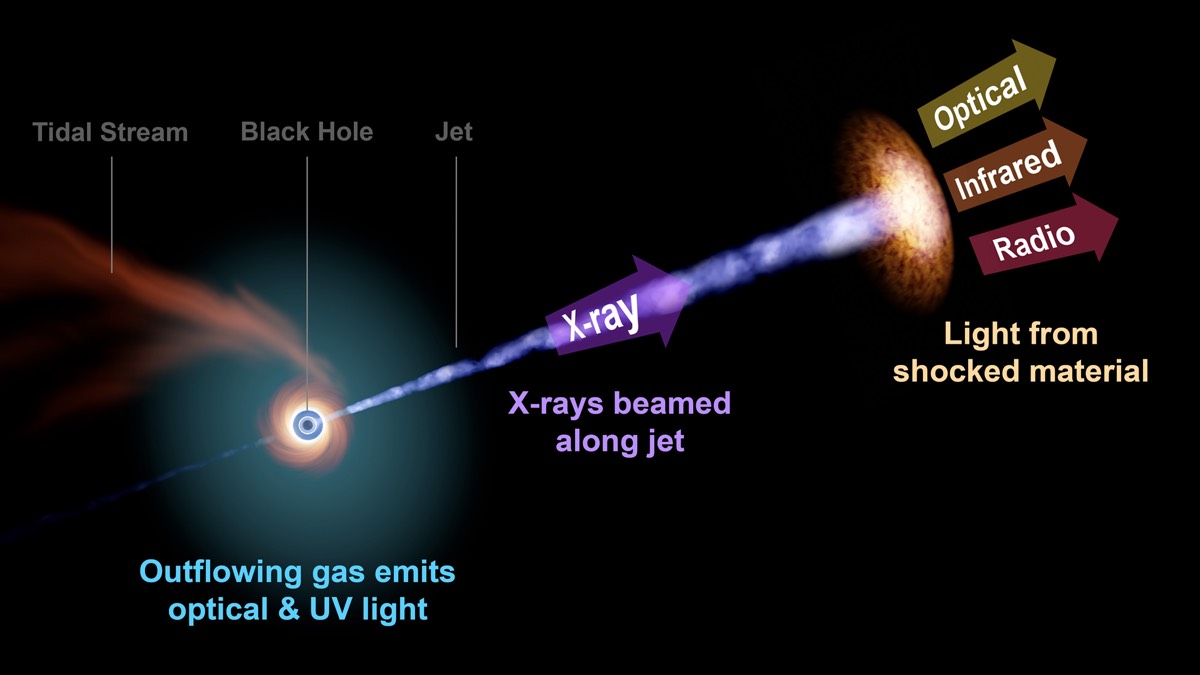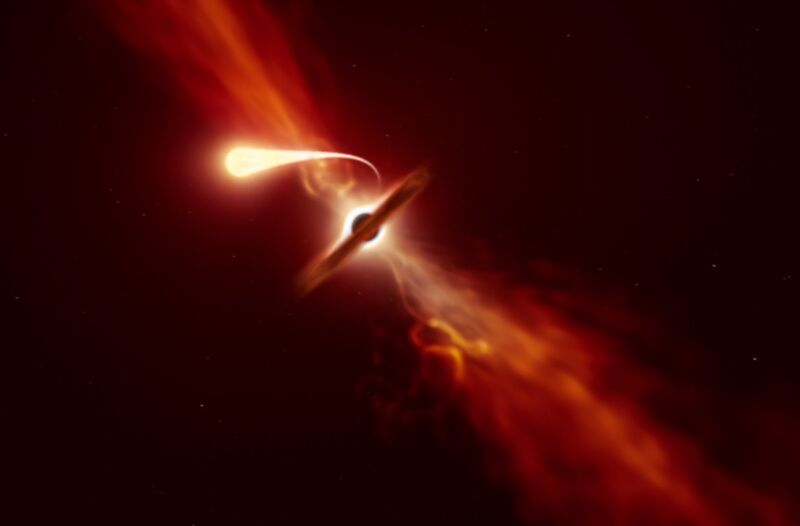Earlier this year, astronomers picked up an unusually bright signal in the X-ray, optical, and radio regimes, dubbed AT 2022cmc. They've now determined that the most likely source of that signal is a supermassive black hole gobbling up a star in a "hyper-feeding frenzy," shooting out jets of matter in what's known as a tidal disruption event (TDE). According to a new paper published in the journal Nature Astronomy, it's one for the record books: the furthest such event yet detected at roughly 8.5 billion light-years away.
The authors estimate the jet from this TDE is traveling at 99.99 percent the speed of light, meaning the black hole is really chowing down on its stellar repast. “It’s probably swallowing the star at the rate of half the mass of the Sun per year,” said co-author Dheeraj “DJ” Pasham of the University of Birmingham. “A lot of this tidal disruption happens early on, and we were able to catch this event right at the beginning, within one week of the black hole starting to feed on the star.”
As we've reported previously, it's a popular misconception that black holes behave like cosmic vacuum cleaners, ravenously sucking up any matter in their surroundings. In reality, only stuff that passes beyond the event horizon—including light—is swallowed up and can't escape, although black holes are also messy eaters. That means that part of an object's matter is ejected in a powerful jet.
If that object is a star, the process of being shredded (or "spaghettified") by the powerful gravitational forces of a black hole occurs outside the event horizon, and part of the star's original mass is ejected violently outward. This, in turn, can form a rotating ring of matter (aka an accretion disk) around the black hole that emits powerful X-rays and visible light—and sometimes radio waves. Physicist John Wheeler once described jetted TDEs as "a tube of toothpaste gripped tight about its middle," such that matter squirts out either end. TDEs are one way astronomers can indirectly infer the presence of a black hole.
For instance, in 2018, astronomers announced the first direct image of the aftermath of a star being shredded by a black hole 20 million times more massive than our Sun in a pair of colliding galaxies called Arp 299, about 150 million light-years from Earth. A year later, astronomers recorded the final death throes of a star being shredded by a supermassive black hole, dubbed AT 2019qiz, which provided the first direct evidence that outflowing gas during disruption and accretion produces the powerful optical and radio emissions previously observed. In January, astronomers spotted a second candidate TDE in the radio regime (dubbed J1533+2727) in archival data collected by the Very Large Array (VLA) telescope in New Mexico.

Astronomers first spotted AT 2022cmc in February and promptly turned multiple telescopes operating across a wide range of wavelengths toward the source. These included an X-ray telescope on board the International Space Station called the Neutron Star Interior Composition Explorer (NICER). It was possible that the bright signal—calculated to be equivalent to the light from 1,000 trillion suns—was a gamma ray burst from the collapse of a massive star. But the data revealed a source 100 times more powerful than even the strongest known gamma ray burst.
“Our spectrum told us that the source was hot: around 30,000 degrees, which is typical for a TDE," said co-author Matt Nicholl of the University of Birmingham. "But we also saw some absorption of light by the galaxy where this event occurred. These absorption lines were highly shifted towards redder wavelengths, telling us that this galaxy was much further away than we expected.”
Given the brightness of AT 2022cmc and its longer duration, astronomers concluded it must be powered by a supermassive black hole. The X-ray data also pointed to an "extreme accretion episode." That's when a whirlpool of debris forms as the unfortunate star falls into the black hole. But the brightness was still a surprise, given how far away the source is from Earth. The authors attribute this to so-called "Doppler boosting," which occurs when the jet points directly toward Earth, much like how the sound of a passing siren gets amplified. AT 2022cmc is only the fourth Doppler-boosted TDE yet found; the last one was detected in 2011.
DOI: Nature Astronomy, 2022. 10.1038/s41550-022-01820-x (About DOIs).



3175x175(CURRENT).thumb.jpg.b05acc060982b36f5891ba728e6d953c.jpg)
Recommended Comments
There are no comments to display.
Join the conversation
You can post now and register later. If you have an account, sign in now to post with your account.
Note: Your post will require moderator approval before it will be visible.